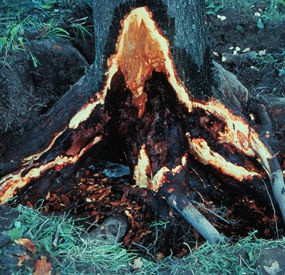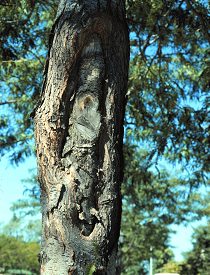
What is Armillaria root disease?
Armillaria root disease, also known as shoestring root rot, is an often lethal disease of tree and shrubs. It can affect almost any conifer or hardwood species, from seedling to maturity. Herbaceous plants can also be affected. Trees and shrubs stressed due to drought or defoliation can be particularly susceptible to Armillaria root disease.
Where does Armillaria root disease come from?
Armillaria root disease results from colonization of trees and shrubs by fungi in the genus Armillaria. These fungi produce tough, cord-like strands called “rhizomorphs” that grow from decaying stumps and roots through the soil. Infection of other trees or shrubs can result from penetration of intact roots by rhizomorphs. In late summer or early fall, honey-colored mushrooms of Armillaria fungi develop near the bases of colonized plants and produce spores that are distributed by wind. Infection also can occur after these spores germinate in wounds on stems or roots.
What does Armillaria root disease look like?
Above-ground symptoms of Armillaria root disease may include slow growth, yellowing and dwarfing of foliage, and thin crowns. Dieback of twigs and branches also may occur as the disease progresses. These symptoms may develop slowly and intensify over many years. However, trees and shrubs also may be rapidly killed, with leaves or needles suddenly wilting or browning on a plant that appeared healthy just days or weeks earlier. Bark on lower stems or roots may be killed and crack, with flow of resin common on conifers. Thin white mats of fungal tissue called “mycelial fans” may be present within and beneath killed bark. Stem and root tissue decayed by Armillaria fungi is often water-soaked, creamy to yellow in color, and spongy or stringy in texture. Rhizomorphs are commonly seen on or beneath the bark and growing from decayed stumps and roots.
How do I save a tree affected by Armillaria root disease?
There is no practical way to eliminate Armillaria from trees that are already colonized by the fungus. The useful life of an affected tree might be prolonged however, by supplemental watering during dry periods and appropriate fertilization to improve overall host condition. In very vigorous trees, the Armillaria fungi may be “walled off” and confined to just a portion of the root system or root collar. There are no chemical treatments that can effectively target Armillaria fungi within diseased trees.
How do I avoid Armillaria root disease in the future?
Practices that maintain trees in vigorous condition are the best means of preventing Armillaria root disease. Watering and fertilization to avoid stress will help trees resist infection. Because Armillaria root disease often develops in response to defoliation, suppression of both insect and leaf pathogen defoliators will indirectly reduce the occurrence and severity of Armillaria root disease. Because stumps and root systems of previously colonized trees can serve as “food bases” supporting rhizomorph growth for many years, thorough removal of stumps and root systems will reduce the risk of infection of other trees.
For more information on Armillaria root disease:
Contact the University of Wisconsin Plant Disease Diagnostics Clinic (PDDC) at (608) 262-2863 or pddc@wisc.edu.
Authors: Michael Amman, UW-Madison Forest Ecology and Management and Glen R. Stanosz, Ph. D., UW-Madison Plant Pathology
Last Revised: 02/28/2024
D-number: D0005
References to pesticide products in this publication are for your convenience and are not an endorsement or criticism of one product over similar products. You are responsible for using pesticides according to the manufacturer’s current label directions. Follow directions exactly to protect the environment and people from pesticide exposure. Failure to do so violates the law.
Thanks to Ann Joy and Brian Hudelson for reviewing this document.
A complete inventory of UW Plant Disease Facts is available at the University of Wisconsin-Madison Plant Disease Diagnostics Clinic website: https://pddc.wisc.edu.
Send a Plant Sample for Analysis
Be cautious when self-diagnosing plant health issues. Very few diseases can accurately be diagnosed by eye.
Contact the UW Plant Disease Diagnostics Clinic (PDDC), and for a small fee, clinic staff can examine a plant, determine the cause of the disease/disorder, and provide advice on how to control or prevent the issue.
Download Article





 Phytophthora Root Rot of Christmas Trees
Phytophthora Root Rot of Christmas Trees Root Rots in the Garden
Root Rots in the Garden Root and Crown Rots
Root and Crown Rots Nectria Canker
Nectria Canker


